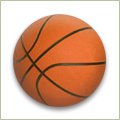 basketballhoopsunlimited.com
basketballhoopsunlimited.comSummer (with its heat and humidity) is almost over, but it's always a good time to think about ways to improve your performance.
For those of you living (and playing ball) in hot, humid climates, here's an interesting study from the United Kingdom that appears in the September 2008 issue of Medicine & Science in Sports & Exercise, the official journal of the American College of Sports Medicine.
Researchers wanted to examine the effects of drinking a cold liquid (instead of one at room temperature) on an athletes body temperature, heart rate, and endurance in the heat.
They took 8 young men (average age =22) and had them pedal on a bicycle to exhaustion in a hot and humid environment, once while drinking a warm (98.6 degrees fahrenheit) liquid and once while drinking the same amount of liquid at a cooler temperature (~39 degrees) .
They found that compared with the warmer liquid, drinking a cold drink before and during exercise in the heat reduced physiological strain (kept the body cooler) and increased the athletes' endurance capacity by more than 20%.
So what does that mean for you? The next time your team is scheduled to play a tournament outside or in a hot gym environment, it might be worth the cost and effort to store your drinks
(water, sports drinks) in a cooler. Don't like to be the one to carry the cooler(s)? Then you can ride the Cooler Train (above). It might help you get where you want to go.









